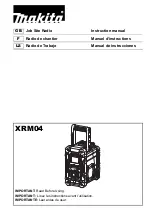
G U A R D I A N V H F 1 1 0 W M O B I L E
3-15
3.5.6.2 CAI
Encryption
The DSP software uses DES kernel software to implement the CAI encryption of voice traffic as described in
TIA/EIA/IS-102.AAAA. The key manager supplies the encryption key. In transmit, the message indicator (MI)
vector is passed to data link processing for encoding and transmission. In receive, the data link layer decodes the MI
vector, and fly wheeled if decoding fails for up to n frames.
3.5.6.3
DES Data Link Layer
This software encrypts and decrypts the 12 kb of CVSD data using the DES kernel. During transmit, framing
synchronization data and the MI vector are inserted into the data stream. In receive, the software searches for and
extracts the framing and MI data. Bit definitions and formats are defined in the DES protocol.
3.5.6.4 Key
Interface
This software provides an interface for inputting DES encryption keys from the DSP SCI port using synchronous
data transfers with an external clock, and for conforming to the Motorola KVL data transfer mechanism and the CAI
DES keyfill protocol.
3.5.6.5 Key
Bank
The radio maintains a bank of up to 16 encryption keys stored in Flash memory. Associated with each key are a key
ID, key data, and an 8-character alphanumeric tag. Each encrypted channel is assigned one of the 16 keys for both
secure transmit and secure receive modes. Channel key assignment is accomplished by selecting the corresponding
key tag. Upon entering the secure transmit or secure receive mode, H8 transfers the appropriate encryption key to
the DSP through the SCI port.
3.5.7 Host
Interface
The DSP is controlled through its host interface by H8. It initially boots up through this interface. The host
interface is used for DSP mode control, encryption key transfer, link control data transfer, low-rate data transfer,
frequency variable data transfer, CTCSS mode control, and initial software download.
3.5.8 Flash
Interface
The DSP has direct access to the main radio Flash memory through the H8 bus arbitration logic. This interface is
used for software downloads using byte-wide direct memory access (DMA) transfers under host control for mode
changes. The DSP software does not write to Flash memory.
3.5.9 Paging
The DSP software is designed so that normal operation does not involve off-chip bus accesses. This means the code
size must be limited to 24K words and the data memory to 10K words. A number of program images that
correspond to different modes are allowed, with paging of images out of Flash by the DMA at mode changes. The
minimum subdivision of images corresponds to the following modes, and a continuously resident core host interface
function.
•
Initialization/POST
•
Receive 12.5 kHz
•
Receive 25 kHz
•
Transmit 12.5 kHz
•
Transmit 25 kHz
•
Keyfill
The paging DMA mechanism is controlled by the host H8 and allows the transfer of a program image within 50 ms.
Содержание G25AMK005
Страница 2: ......
Страница 8: ......
Страница 30: ......
Страница 60: ......
Страница 62: ...7 2 G U A R D I A N V H F M O B I L E...
Страница 66: ...9 2 G U A R D I A N V H F M O B I L E...
Страница 69: ...G U A R D I A N V H F 1 1 0 W M O B I L E 11 1 CHAPTER 11 SCHEMATICS...
















































